Home > Directory of Drawing Lessons > How to Improve Your Drawings > Troubleshooting Art > Correcting Our Drawings
CORRECTING OUR DRAWINGS : HOW TO MAKE CORRECTIONS TO OUR ARTWORK
|
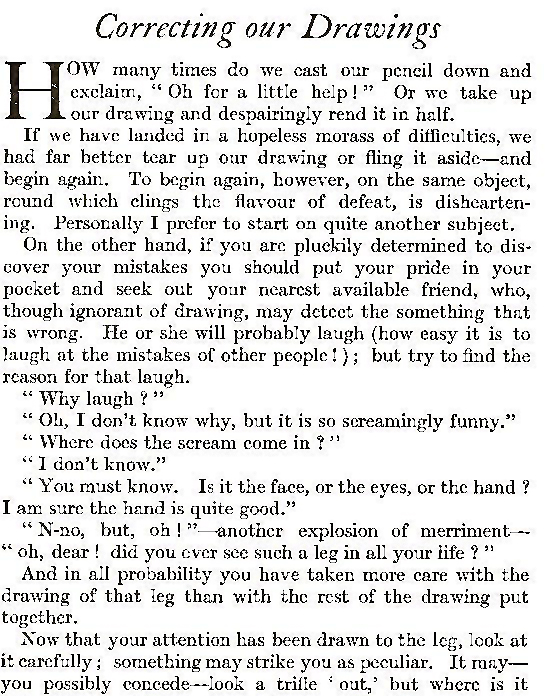
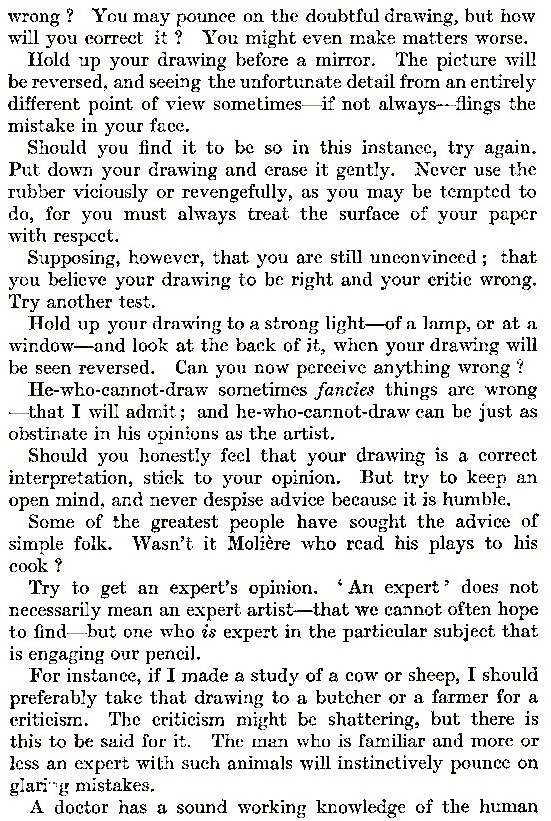
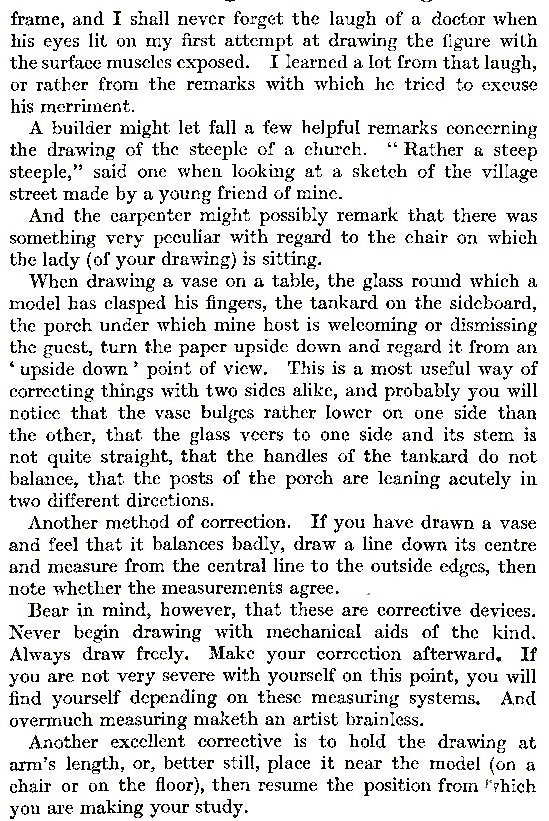
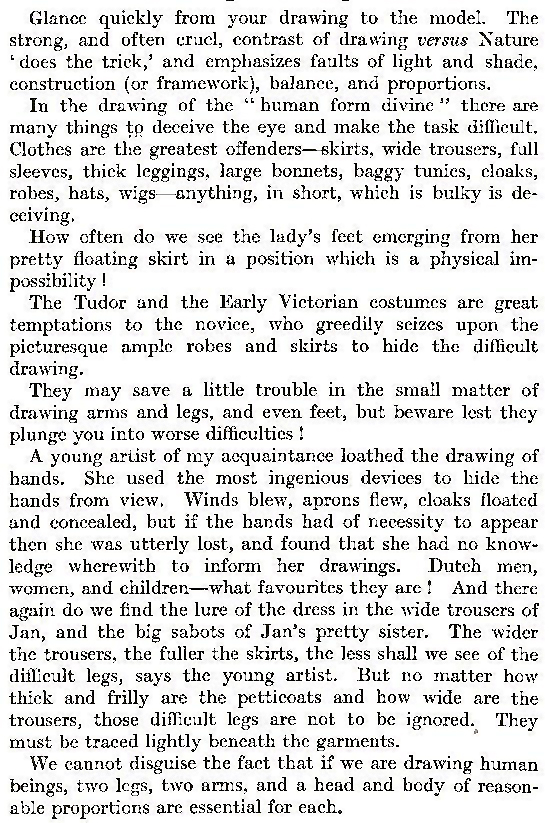
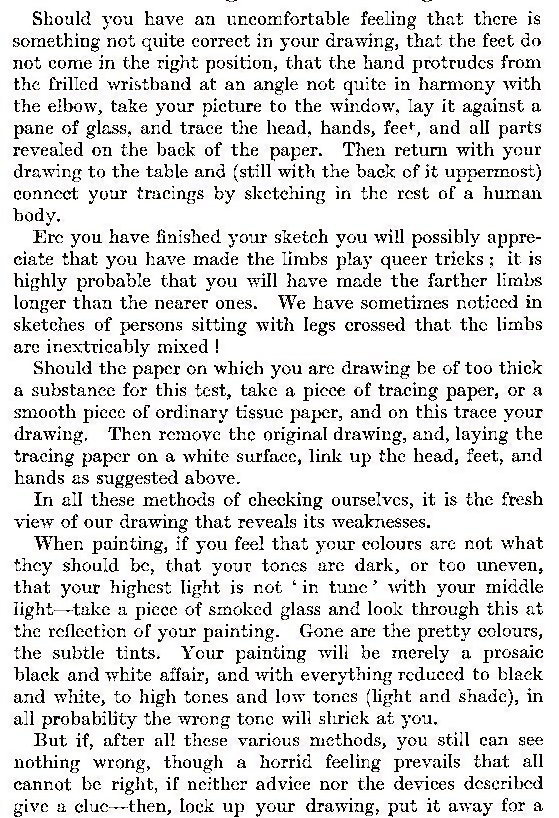

GO BACK TO THE HOME PAGE FOR TUTORIALS FOR BEGINNING ARTISTS
[The above words are pictures of text, below is the actual text if you need to copy a paragraph or two]
Correcting our Drawings
How many times do we cast our pencil down and exclaim, " Oh for a little help ! " Or we take up our drawing and despairingly rend it in half.
If we have landed in a hopeless morass of difficulties, we had far better tear up our drawing or fling it aside—and begin again.
To begin again, however, on the same object, round which clings the flavour of defeat, is disheartening. Personally I prefer to start on quite another subject.
On the other hand, if you are pluckily determined to discover your mistakes you should put your pride in your pocket and seek out your nearest available friend, who, though ignorant of drawing, may detect the something that is wrong. He or she will probably laugh (how easy it is to laugh at the mistakes of other people ! ) ; but try to find the reason for that laugh.
" Why laugh ? "
" Oh, I don't know why, but it is so screamingly funny." " Where does the scream come in ? "
" I don't know."
" You must know. Is it the face, or the eyes, or the hand ? I am sure the hand is quite good."
" N-no, but, oh ! "—another explosion of merriment" oh, dear ! did you ever see such a leg in all your life ? "
And in all probability you have taken more care with the drawing of that leg than with the rest of the drawing put together.
Now that your attention has been drawn to the leg, look at it carefully ; something may strike you as peculiar. It may—you possibly concede—look a trifle ' out,' but where is it wrong ? You may pounce on the doubtful drawing, but how will you correct it? You might even make matters worse.
Hold up your drawing before a mirror. The picture will be reversed, and seeing the unfortunate detail from an entirely different point of view sometimes—if not always—flings the mistake in your face.
Should you find it to be so in this instance, try again. Put down your drawing and erase it gently. Never use the rubber viciously or revengefully, as you may be tempted to do, for you must always treat the surface of your paper with respect.
Supposing, however, that you are still unconvinced ; that you believe your drawing to be right and your critic wrong. Try another test.
Hold up your drawing to a strong light—of a lamp, or at a window—and look at the back of it, when your drawing will be seen reversed. Can you now perceive anything wrong?
He-who-cannot-draw sometimes fancies things are wrong —that I will admit ; and he-who-cannot-draw can be just as obstinate in his opinions as the artist.
Should you honestly feel that your drawing is a correct interpretation, stick to your opinion. But try to keep an open mind, and never despise advice because it is humble.
Some of the greatest people have sought the advice of simple folk. Wasn't it Moliere who read his plays to his cook?
Try to get an expert's opinion. ' An expert' does not necessarily mean an expert artist—that we cannot often hope to find—but one who is expert in the particular subject that is engaging our pencil.
For instance, if I made a study of a cow or sheep, I should preferably take that drawing to a butcher or a farmer for a criticism. The criticism might be shattering, but there is this to be said for it. The man who is familiar and more or less an expert with such animals will instinctively pounce on glari -.g mistakes.
A doctor has a sound working knowledge of the human frame, and I shall never forget the laugh of a doctor when his eyes lit on my first attempt at drawing the figure with the surface muscles exposed. I learned a lot from that laugh, or rather from the remarks with which he tried to excuse his merriment.
A builder might let fall a few helpful remarks concerning the drawing of the steeple of a church. " Rather a steep steeple," said one when looking at a sketch of the village street made by a young friend of mine.
And the carpenter might possibly remark that there was something very peculiar with regard to the chair on which the lady (of your drawing) is sitting.
When drawing a vase on a table, the glass round which a model has clasped his fingers, the tankard on the sideboard, the porch under which mine host is welcoming or dismissing the guest, turn the paper upside down and regard it from an ' upside down '
point of view. This is a most useful way of correcting things with two sides alike, and probably you will notice that the vase bulges rather lower on one side than the other, that the glass veers to one side and its stem is not quite straight, that the handles of the tankard do not balance, that the posts of the porch are leaning acutely in two different directions.
Another method of correction. If you have drawn a vase and feel that it balances badly, draw a line down its centre and measure from the central line to the outside edges, then note whether the measurements agree.
Bear in mind, however, that these are corrective devices. Never begin drawing with mechanical aids of the kind. Always draw freely. Make your correction afterward. If you are not very severe with yourself on this point, you will find yourself depending on these measuring systems. And overmuch measuring maketh an artist brainless.
Another excellent corrective is to hold the drawing at arm's length, or, better still, place it near the model (on a chair or on the floor), then resume the position from khich you are making your study.
Glance quickly from your drawing to the model. The strong, and often cruel, contrast of drawing versus Nature ' does the trick,' and emphasizes faults of light and shade, construction (or framework), balance, and proportions.
In the drawing of the " human form divine " there are many things tp deceive the eye and make the task difficult. Clothes are the greatest offenders—skirts, wide trousers, full sleeves, thick leggings, large bonnets, baggy tunics, cloaks, robes, hats, wigs— anything, in short, which is bulky is deceiving.
How often do we see the lady's feet emerging from her pretty floating skirt in a position which is a physical impossibility!
The Tudor and the Early Victorian costumes are great temptations to the novice, who greedily seizes upon the picturesque ample robes and skirts to hide the difficult drawing.
They may save a little trouble in the small matter of drawing arms and legs, and even feet, but beware lest they plunge you into worse difficulties!
A young artist of my acquaintance loathed the drawing of hands. She used the most ingenious devices to hide the hands from view.
Winds blew, aprons flew, cloaks floated and concealed, but if the hands had of necessity to appear then she was utterly lost, and found that she had no knowledge wherewith to inform her drawings. Dutch men, women, and children—what favourites they are! And there again do we find the lure of the dress in the wide trousers of Jan, and the big sabots of Jan's pretty sister. The wider the trousers, the fuller the skirts, the less shall we see of the difficult legs, says the young artist. But no matter how thick and frilly are the petticoats and how wide are the trousers, those difficult legs are not to be ignored.. They must be traced
lightly beneath the garments.
We cannot disguise the fact that if we are drawing human beings, two legs, two arms, and a head and body of reasonable proportions are essential for each.
Should you have an uncomfortable feeling that there is something not quite correct in your drawing, that the feet do not come in the right position, that the hand protrudes from the frilled wristband at an angle not quite in harmony with the elbow, take your picture to the window, lay it against a pane of glass, and trace the head, hands, feel-, and all parts revealed on the back of the paper. Then return with your drawing to the table and (still with the back of it uppermost) connect your tracings by sketching in the rest of a human body.
Ere you have finished your sketch you will possibly appreciate that you have made the limbs play queer tricks ; it is highly probable that you will have made the farther limbs longer than the nearer ones. We have sometimes noticed in sketches of persons sitting with legs crossed that the limbs are inextricably mixed!
Should the paper on which you are drawing be of too thick a substance for this test, take a piece of tracing paper, or a smooth piece of ordinary tissue paper, and on this trace your drawing. Then remove the original drawing, and, laying the tracing paper on a white surface, link up the head, feet, and hands as suggested above.
In all these methods of checking ourselves, it is the fresh view of our drawing that reveals its weaknesses.
When painting, if you feel that your colours are not what they should be, that your tones are dark, or too uneven, that your highest light is not ' in tune ' with your middle light—take a piece of smoked glass and look through this at the reflection of your painting. Gone are the pretty colours, the subtle tints. Yout painting will be merely a prosaic black and white affair, and with everything reduced to black and white, to high tones and low tones (light and shade), in all probability the wrong tone will shriek at you.
But if, after all these various methods, you still can see nothing wrong, though a horrid feeling prevails that all cannot be right, if neither advice nor the devices described give a clue—then, lock up your drawing, put it away for a few days, or a few months, until you have entirely forgotten the circumstances in which it was drawn. When you again examine it the chances arc that you will see at once what is wrong.
Either you will say, " How could I miss seeing that mistake? " or (and, believe me, the chances of this are very remote), " Why !
there is nothing wrong—after all."
Privacy Policy ...... Contact Us




